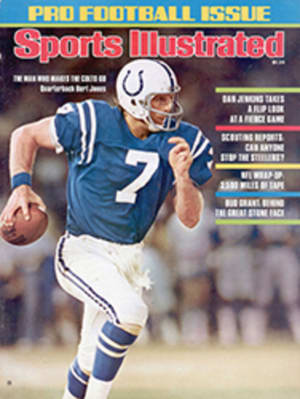
The throes of frustration
Because the Mets are really sockin' that ball,
Hittin' those home runs over the wall.
—from Meet the Mets
Good pitching, it is generally acknowledged, will beat good hitting. The question is: Can the pitching staff that is decidedly the best in the majors overcome pathetic hitting—when those weak bats are in its own lineup? That staff belongs to the Mets, a team whose pitchers have an earned run average of 2.91, but whose hitters are an embarrassment, even to their own theme song.
While the Mets' team ERA is lower than Steve Carlton's or John Candelaria's, the team batting average is only .244. On 28 occasions this season. Met starters have allowed three runs or less, and lost or got no decision.
Tom Seaver (2.41), Jon Matlack (2.86), Jerry Koosman (2.91) and Mickey Lolich (2.95) rank first, seventh, eighth and 10th among National League starters in ERA, but their stomachs churn with the same pitch-by-pitch anxiety as that of the humblest reliever. When you pitch for the Mets, one mistake can be disastrous.
"It's like a damned broken record," says Seaver, who leads the league in strikeouts and heartbreaks and who suffered through a nightmarish seven-week period this summer in which he did not win a game despite some typically Seaverian statistics: seven starts, 55 innings pitched, 13 earned runs, 2.13 ERA and three home runs allowed. For his efforts he was rewarded with four defeats and three no-decisions. Harking back to the days of Marv Throneberry, the Mets managed to score only nine runs in his behalf. Last Friday night they were just as niggardly, scoring only one run. But Seaver pitched up his 11th win (he has lost 10) by shutting out the Phillies. By whiffing eight batters he extended his own record for consecutive 200-strike-out seasons to nine.
In this unholy tug-of-war between New York's pitchers and hitters, the pitchers lead the league in shutouts (16), while the hitters are second to San Francisco in being shut out (16). Seaver has been shut out five times; Lolich has been treated worse. His teammates have scored only 3.17 runs per nine innings during his starts. In fact Lolich's 7-11 record is so out of proportion to the way he has pitched that his misfortunes cannot be blamed strictly on weak hitting. New York, it turns out, has another serious deficiency: defense, particularly in the outfield.
"The pitcher's job is to keep the ball in the park," says Joe Torre, the team's only .300 hitter. "Then it's up to the outfielders. We've had a lot of balls hit in the air this year that didn't go out but weren't caught."
Matlack, whose 14-8 record, along with Koosman's 17-8, indicates that the Mets have reserved most of their ineptitude for Seaver and Lolich, hit the ceiling in June when Dave Kingman misjudged a fly ball to right field, allowing the weak-hitting Giants to score five runs in the first inning. "The trouble with this club," Matlack said later, "is that you don't have to take fly balls in practice. If you did, you might catch that ball."
That was harsh criticism of both the manager and of Kingman, whose 32 home runs and 72 RBIs have provided much of the Met offense. And Kingman's faux pas was scarcely an isolated occurrence. In the ninth inning of a 1-1 game at Montreal, Matlack's roommate, Ed Kranepool, charged in for a line drive that sailed over his head and made Koosman a 2-1 loser. "I thought it was going to sink," said Kranepool. "Obviously I went the wrong way." Life has been like that for Koosman this season: the Mets have scored only 12 runs in his eight losses.
The team has played 50 one-run games this year, and the way they have scratched to win 23 of them cries out for the introduction of some new baseball headlines, such as "New York Wins 2-1 Slaughter" or "Mets in 3-2 Romp." Koosman enjoyed just such a laugher last week. He beat San Francisco 1-0—and had to wait until the eighth inning before New York scored its run. That win helped keep the third-place Mets over .500, no mean feat for a team with the fourth worst batting average in the majors.
"It's been this way for a long time," says Koosman. "Pitching is what the Mets didn't have when they started, so they've stressed it in their scouting ever since. We've never really had good, aggressive hitting—the kind the Reds have that rubs off on everybody. What did Seaver and Lolich and I say to each other after all three of us were shut out in a four-day span? I won't tell you. Our hitters would never get me another run."
"People have been talking about this season like it's a novelty," says Lolich, "but I was always the guy who got dumped on in Detroit. I may have had the worst runs-scored-for statistic in the American League last year. Remember 1968 when Denny McLain won 31 games? The Tigers averaged 5.1 runs per game for him."
"I'd take my chances with that," says Seaver, whose 11-10 record also reflects a cruel financial irony. Under the terms of his new three-year contract, Seaver was to receive a $5,000 bonus for every five-day period between his 19th victory and the end of the season. In many ways, Seaver has pitched as well as the Padres' Randy Jones, who won his 19th game on Aug. 10. In the same situation, Seaver already would have banked $25,000 in incentive money, with another $20,000 to follow before the end of the season.
Recently Matlack started against the Dodgers, and when Met Catcher Ron Hodges flied out to end the first inning, narrowly missing a grand slam home run, Matlack sensed he was in for a typical day. In one swing Hodges had nearly provided him with as many runs as he had seen in one game during his previous five starts, but like most balls hit by the Mets, it was a few feet short. The Dodgers took a 1-0 lead in the second on two quick doubles. Hodges, in the early stages of an 0-for-20 slump, hit into a bases-loaded double play in the third. Considering the two bases-loaded scoring opportunities that went by the board, Matlack felt fortunate that the game was tied 1-1 as Third Baseman Roy Staiger led off the last of the ninth. Staiger was in the midst of what would become an 0-for-18 streak, but he reached base on an error. At that point, Matlack left the game for a pinch hitter, Torre, another long day's work apparently wasted. However, Torre got an infield hit. A walk loaded the bases. With typical Met economy, Felix Millan then won the game with a 35-foot dribbler that could not be fielded in time to get a force at home.
The final score was 2-1. To Met pitchers, it was just another rout.
PHOTO
MATLACK BEMOANS MISJUDGED FLY BALLS

